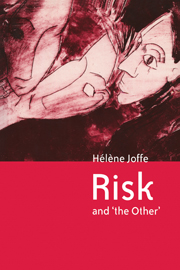Book contents
- Frontmatter
- Contents
- Preface
- Acknowledgements
- 1 Responses to risks: an introduction
- 2 Human responses to risks: ‘not me’, ‘the other is to blame’
- 3 A study of lay people's responses to a risk: HIV/AIDS in Britain and South Africa
- 4 Evaluating two social psychological models of the response to risks
- 5 The source of linking risk and ‘the other’: splitting objects into ‘good’ and ‘bad’
- 6 Social representations of risks
- 7 Emotional life: a new frontier for social theory
- 8 Changing social representations of risks
- References
- Index
7 - Emotional life: a new frontier for social theory
Published online by Cambridge University Press: 22 September 2009
- Frontmatter
- Contents
- Preface
- Acknowledgements
- 1 Responses to risks: an introduction
- 2 Human responses to risks: ‘not me’, ‘the other is to blame’
- 3 A study of lay people's responses to a risk: HIV/AIDS in Britain and South Africa
- 4 Evaluating two social psychological models of the response to risks
- 5 The source of linking risk and ‘the other’: splitting objects into ‘good’ and ‘bad’
- 6 Social representations of risks
- 7 Emotional life: a new frontier for social theory
- 8 Changing social representations of risks
- References
- Index
Summary
The social science of the 1990s has seen a resurgence in interest in the emotions. Despite emotion having been the concern of philosophy for many centuries, the contemporary science of emotion has tended to be produced by those working within a psychological framework. The primacy of psychology in the emotions field as a whole relates to a conceptualisation of emotion as a matter of individual expression and experience (Strongman, 1996). It is also linked to the rising legitimacy of neuro-psychological explanations in science more generally. The focus on the intra-psychic aspects of emotion has thwarted the development of theories of emotion in terms of their more social, cultural and historical attributes. However, the socio-cultural approach has recently gained ground. In this chapter I evaluate key components of the current emotions literature. I build up a conceptualisation of emotional life which is essentially relational and cultural, but not always accessible to consciousness. My concern is with the insight that the emotions literature offers into the response to risks, often mass risks. This response manifests in the representations of the risks which are formed. This chapter is less focused upon risk and ‘the other’ than the preceding chapters. It examines a literature which has not previously been linked with risk, but which provides interesting angles on fear and the self-protective elements which are crucial for a theory of the response to risks.
- Type
- Chapter
- Information
- Risk and 'The Other' , pp. 107 - 125Publisher: Cambridge University PressPrint publication year: 1999

